During our first year of living on our sailboat I kept a running list of sailing maintenance tips, tricks and little known secrets. Some of the items noted are big-time money and/or time savers and others are simply common sense that isn’t common when you’re a newbie sailor. Considering that this has been our first year living on a sailboat full time our learning curve has been massive.
I’m sure someone could create volumes of sailing maintenance tips and tricks but those listed below really made an impact on me
And I thought that perhaps a few might make an impact on you too!?
What’s your top sailing maintenance and living tip, trick or secrete? Can you add to list? If yes, please leave a comment below the article.
My top 15 sailing maintenance tips – the list is not ranked in any priority
1. Saving the Gelcoat
When staying in a marina, if there’s enough room either side of the boat, tie your fenders in a way that allows them to rest on the top outside corner of the deck rather than along side of the hull.
By having the fenders pointing out and away from the hull it reduces the likelihood of the hull exterior or gelcoat from being worn down. (If you like my sailing t-shirt I’m wearing below and want to get one for yourself or your partner, visit my shop)
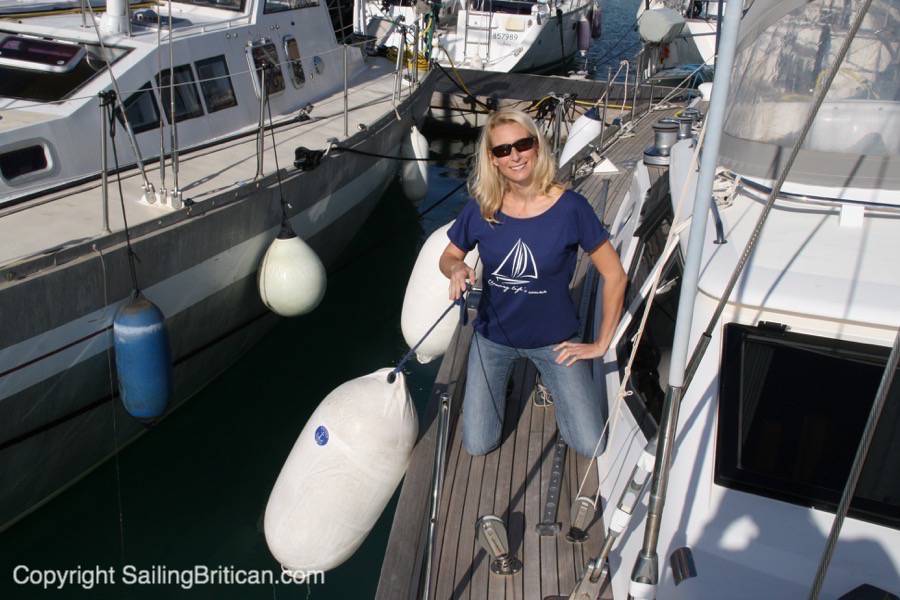
2. Keeping your propeller shiny
Would you like your propeller to look shiny and new even after a whole season in the water?
Avoid buying any fancy shmancy propeller solution! The secrete is to paint your prop with egg whites! When your boat is out of the water (perhaps when you get it antifouled) paint a coat of egg whites on the prop, let it dry and then repeat four more times. I discovered this tip after being laid up next to a boat crane at the end of a season in the Mediterranean.
My family and I watched about eight boats a day for three weeks be hauled out for the winter. One boat, in particular, came out with the shiniest propeller we’d seen the whole time during our stay. My husband had to ask him what product the boat owner used as all the other props were barnacle ridden, brown-green and disgusting.
We were all flabbergasted when we heard the egg whites answer!
Make sure to read the comments below as a reader also suggests that lanolin works wonders too.
3. Putting a stop to squeaky floorboards?
During the evening do you attempted to sneak into the galley to grab a cookie only to be exposed by a squeaky floorboard? Try rubbing candle wax on the underside of your floorboards to prevent floor squeak. Another tip is talcum, or baby, powder.
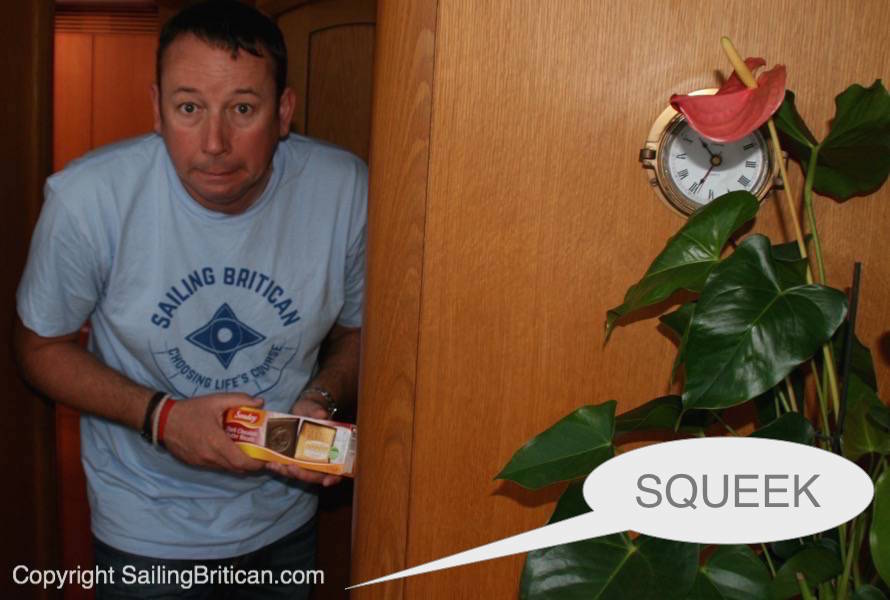
4. Teak Deck Comfort
Over time the black stuff between your teak boards on your deck expands upwards.
When it gets too high it can become uncomfortable to walk on and worse, it creates areas where water can pool on the teak surface – a no-no. Every so often, you’re suppose to ‘skim’ the black stuff down so that it’s level with the teak boards or very slightly lower.
Most people painstakingly use a chisel to remove the black stuff however the secrete is to use one of those snap off box knife razor blades
By slightly bending the blade and skimming along the black stuff you get the perfect shape and it’s a rather quick method. Make sure to tape something around your fingers, however, as holding the blade in the same position can cause a callus and finger-ache 🙁
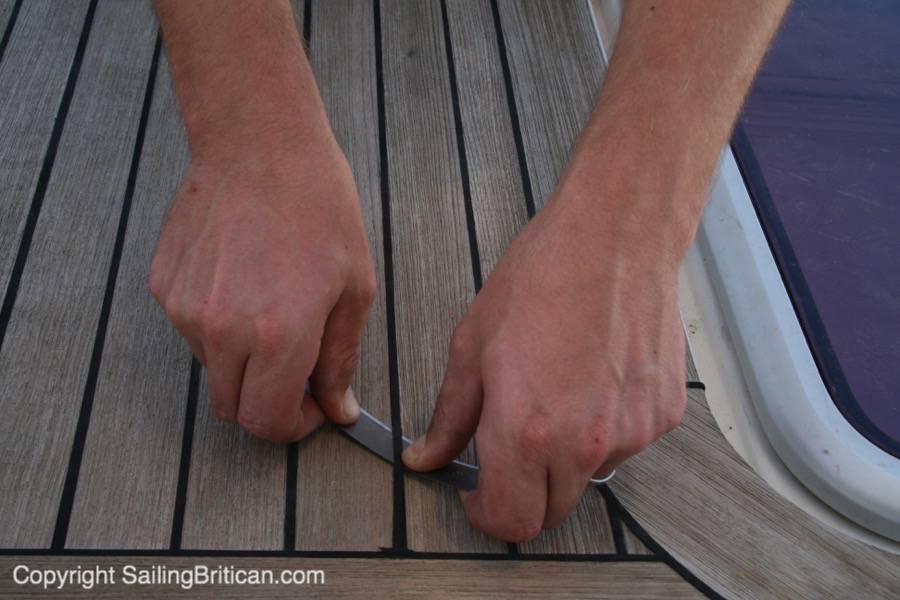
5. Here’s how to make sure your stern gland is dripping!
If you have a stern gland it’s suppose to drip every minute while in use.
Read my article “When I thought things couldn’t get any worse, they have – looks like we might have fried our propeller shaft” for more information on the stern gland.
There’s two issues with the stern gland dripping. The first is that it’s hard to make sure it’s happening. If you blink you might just miss the drip! Also, it’s not a good idea to have a flow of salt water making it’s way through your bilge. The solution?!
My husband affixed one side of Velcro on the hull under the stern gland, and then the other onto a Tupperware container
The Velcro was the type with stickers on either side. Now…we can pour the salt water out if gets high and more importantly we can determine whether or not our stern gland is dripping!
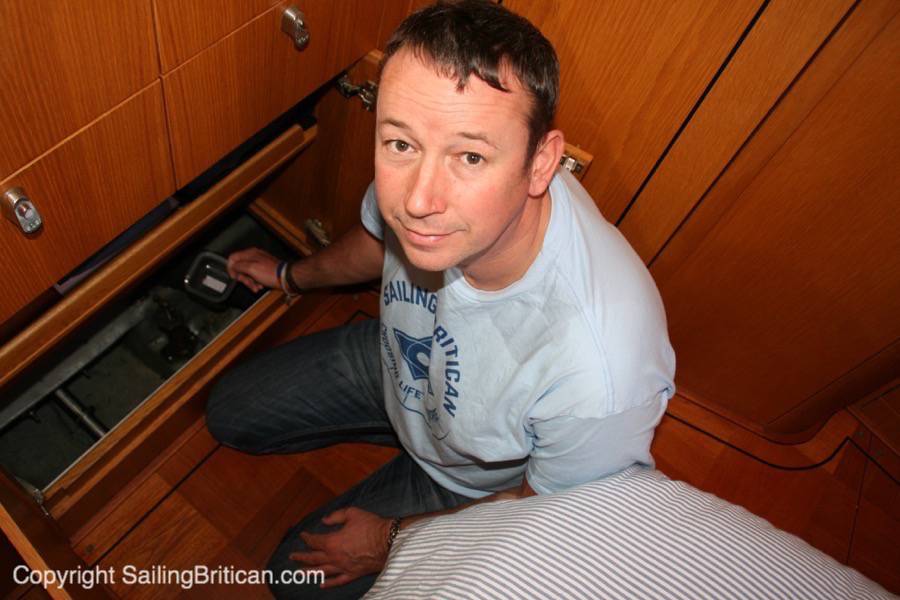
Below is a picture of our stern gland with the Tupperware container affixed below the drip area.
When we first got our boat we knew that the gland should have been dripping but we didn’t know how or why. After a full season of sailing we discovered that our gland was closed tight, not enabling the drip and reducing the cooling and lubrication process. Fortunately for us we didn’t damage anything.
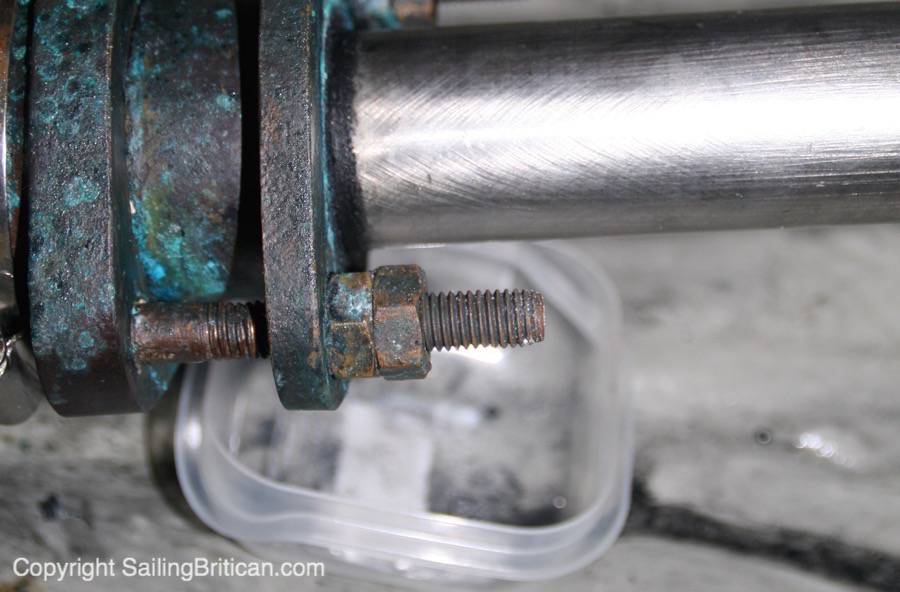
6. The magic of warm water and vinegar
What’s the best solution to clean the interior wood, ceiling panels and bathroom? Yep…it’s vinegar.
I think there’s a book out there about the 500 uses for vinegar. The stuff is amazing. I use it to clean the toilets, wash any mould that develops off the walls and on our ceiling. Not only is it environmentally friendly but it works!
And a note about mold…I’ve included a picture below of what mold looks like on wood so you can identify it – this is actually called mildew. When I leave the boat for any duration of time (a couple weeks or more) whenever I come back my walls have a white substance on them. At first I thought it was dust and I was okay with that. Recently I’ve been told that it’s mold. How disgusting is that?! Read my Top 14 Boat Mold Removal tips article for an in-depth explanation of mold. The article includes various ways you can prevent and remove it.
Apparently, if we ran a dehumidifier while we’re gone it will reduce the likelihood of mold but that’s yet another device to buy and store. Anyway, mold can easily come off using a vinegar and warm water solution…
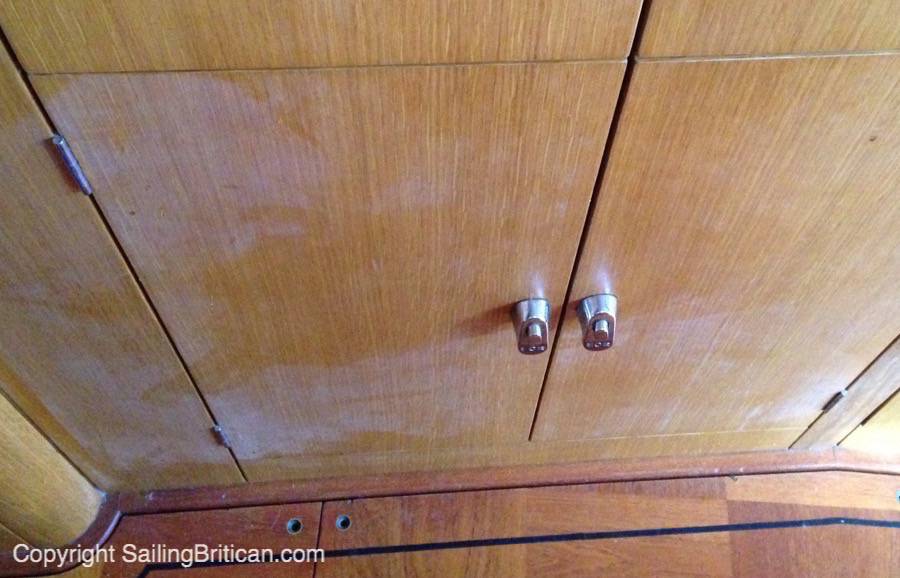
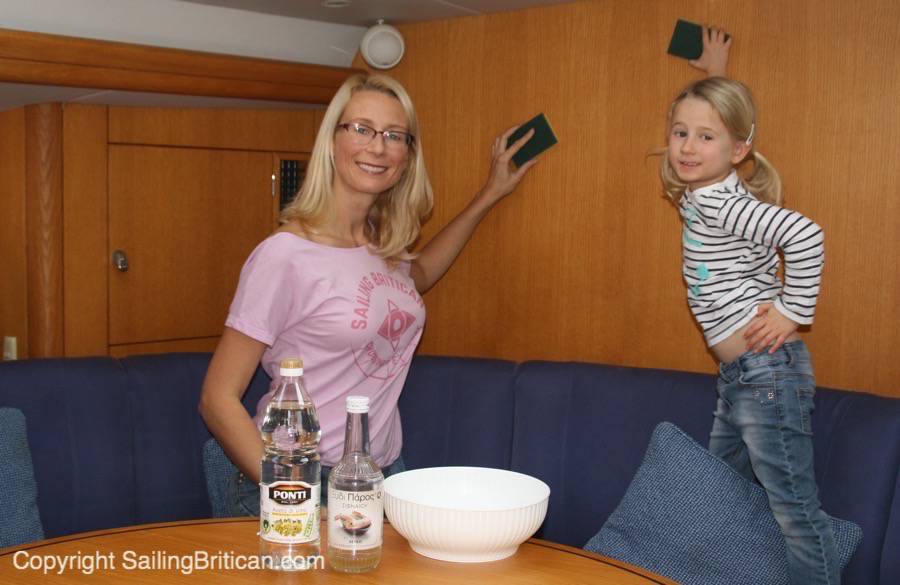
7. Invest in a clothesline unless you want all your clothes to have rips and rust stains!
Now that we’ve spent a year on the boat I’m not exaggerating when I say that every towel, bed linen and article of clothing that we own has a rust stain on it.
The picture below doesn’t really show the rust stains but it does show my ‘mad face’!
Unbeknown to me, I innocently spent the summer drying our laundry on the safety rails that surround the boat. Not knowing the source, rust stains started to appear on everything. It didn’t take long to realize that our safety lines had spots of rust (unseen by the naked eye) and were therefore transferring the stain onto our clothes.
After trying to clean the rust off the safety lines I then had laundry with long black stains across everything – it must have been the rust solution that I evidently didn’t wash off good enough. In the end, I discovered that the best solution is to buy a clothesline and attach it from the mast to the front of the boat. I now only put darks on the safety line!
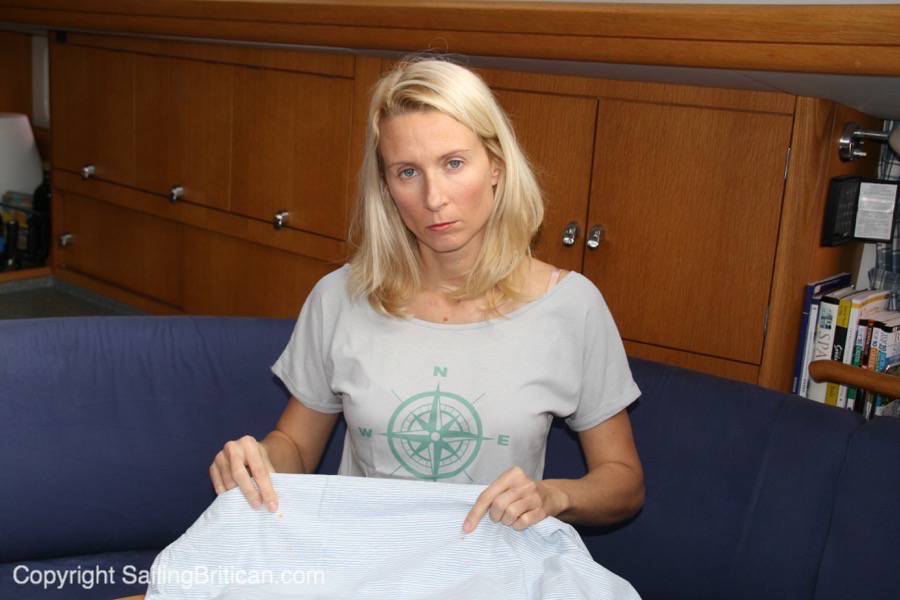
8. The best clothespins?!
Speaking of clotheslines, I find that the best clothespins are the wooden type.
The plastic pegs will only last a season or two at most
The sun, sea air and sailing conditions seem to destroy plastic quickly. Often, I’ll use a clothespin and it will snap off sending a bit of plastic in one direction or another. The LAST THING our seas need is more plastic. I’ve changed all my clothespins to the wooden type now.
9. Always say ‘no’ to anyone trying to sell you something or to help service your boat
Never agree to buy anything from anyone when you first meet them.
I suppose this tip is the same in the land-based world too
But when you’re a newbie you can often be swept up with the abundance of kindness offered within the sailing community. What am I talking about? Well, the first quote I had for new sails for the boat came to €23k. The person that offered to make them for us was a wonderful guy (and I still think he’s wonderful) but the sails on offer were not only beyond our budget, they were not exactly what we needed.
I gave my word (that I later had to break) that we were going to buy the sails thinking that we were getting a good deal only to find out that what we needed/wanted would cost us around €14k. BIG DIFFERENCE.
Like anywhere in the world, you’ll meet great people that offer a great variety of products and services. Don’t change what you’d normally do – always go out, get several quotes and talk to several people before making a commitment to making a large purchase. See the picture below to discover why we need new sails!

10. Before moving onto your boat, go to IKEA and buy as many plastic containers as you think you can store.
You will use these for all sorts. First of all, anything that comes in cardboard needs to be removed and repackaged. Cereal boxes, pasta boxes, outer cardboard covers. This needs to be done for two very important reasons. The first is that cockroaches lay eggs in cardboard and if you happen to get some cardboard with some eggs on the boat you’ll have a massive situation on your hands.
The second reason is bugs (other than cockroaches)
Bugs are latent in all sorts of products – flour and pasta come to mind immediately. This year I’ve had pasta that I’ve taken out and the bag it was sealed in was full of living, crawling bugs. If that pasta was in a cardboard box, rather than a bag, my whole cupboard would have been full of bugs. The bugs can’t escape plastic or Tupperware but they can easily get out of cardboard boxes. I put flour, polenta, rice, pasta and anything that comes in a box into Tupperware immediately and discard the boxes.
I often use the smaller plastic containers for odd pieces of stuff (screws, etc.), my daughters hair clips or office stuff like paper clips and so on. The pack displayed below is from Ikea and stacks within itself to take up very little space. The cost to buy is cheap so if you give a neighbor left-overs and they forget to return the container it’s no big deal.
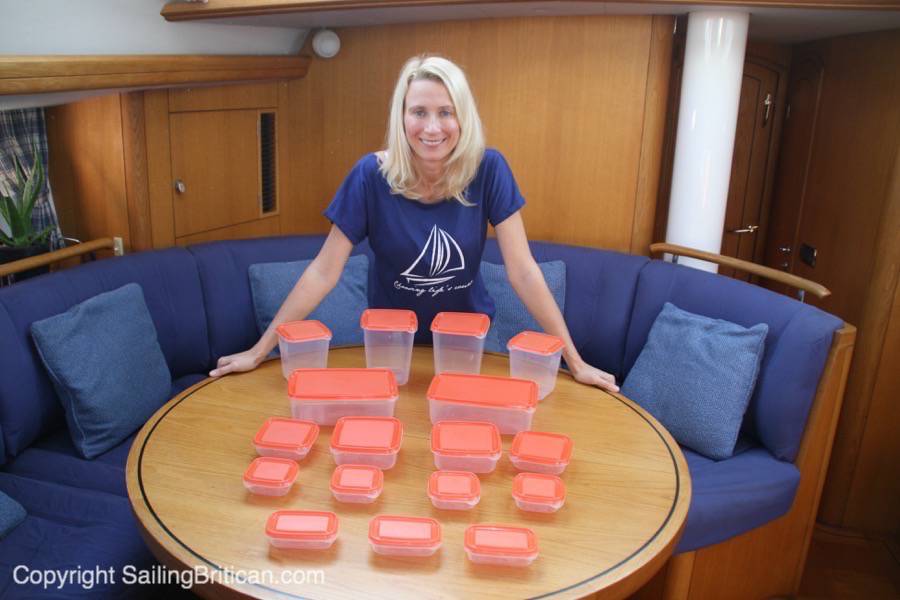
11. Use it or loose it – run all your systems every week
Some sailors will disagree with me on this but based on the courses I took I’m a firm believer that on a boat if you don’t use it you lose it. Things like pumps, refrigeration units, air conditioners, engines and so forth all need to run on a weekly, if not monthly, basis.
When we were laid up in Sicily for the winter for five months, every Monday we turn on everything that runs.
Just take an impeller, for example. These little plastic wheels found within pumps are stuck in one position once the pump is turned off. If they’re not moved around they can become weak and brittle.
Perhaps they need lubrication or the pieces that are bent the most need a change of position
If you ask any boat professional, they always say that the majority of issues come from commissioning a boat after wintering. If you’re not wintering your boat, exercise everything at least every month. This also applies to seacocks too. If you don’t move them around, barnacles grow, seawater sets in and they won’t move.
When a pipe busts and you can’t close a seacock it’s not a pretty sight!
12. Another tip about fenders…Fenders are not cheap!
It makes me feel sick if we lose one as ours cost around €80 each. That being noted, if you’re going to moor up along side a cement wall it’s very important to carry a plank of wood to put over the fenders so that it’s positioned between the fenders and the wall. Otherwise your fenders will be slowly eaten up and eventually destroyed by the wall.
Furthermore, make sure to put your boat name and your phone number/email address on the fender. If one goes missing you might just hear from someone that finds it.
13. Make sure you have a multimeter.
At first I was afraid of these handy devices however this year I’ve used it time and time again.
They help to determine if electricity is flowing and the amount that is flowing! They even help to let you know if a light bulb is good or dead. Before taking anything electrical apart, a multimeter helps to troubleshoot a whole variety of issues. Below is my husband checking the voltage of our batteries.
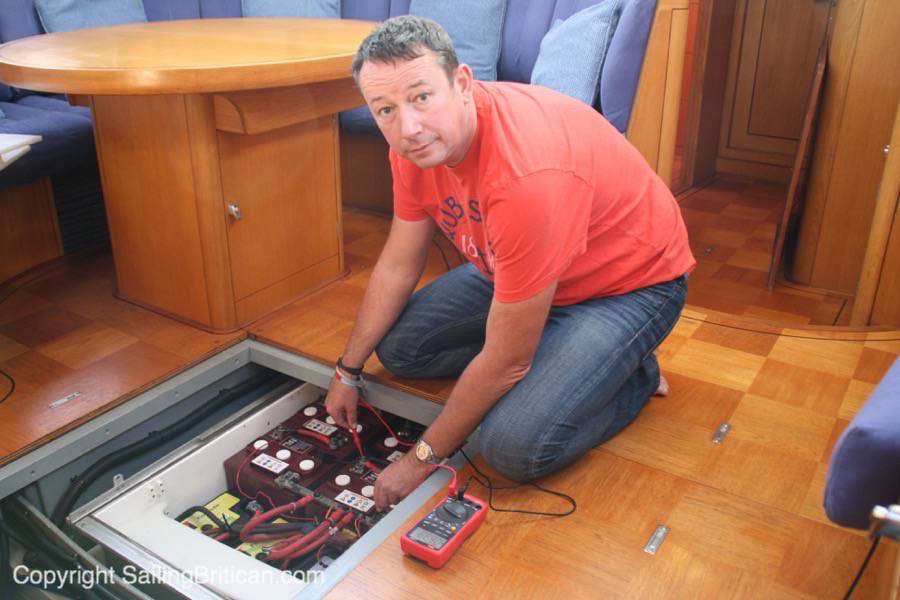
14. Vaseline your hatches and window seals – better yet, use a Silicone Grease.
If you do this on a routine basis it will keep the plastic soft rather than allow it to dry out and become brittle. My husband looks like he’s enjoying this job a little bit too much! (Scary!)
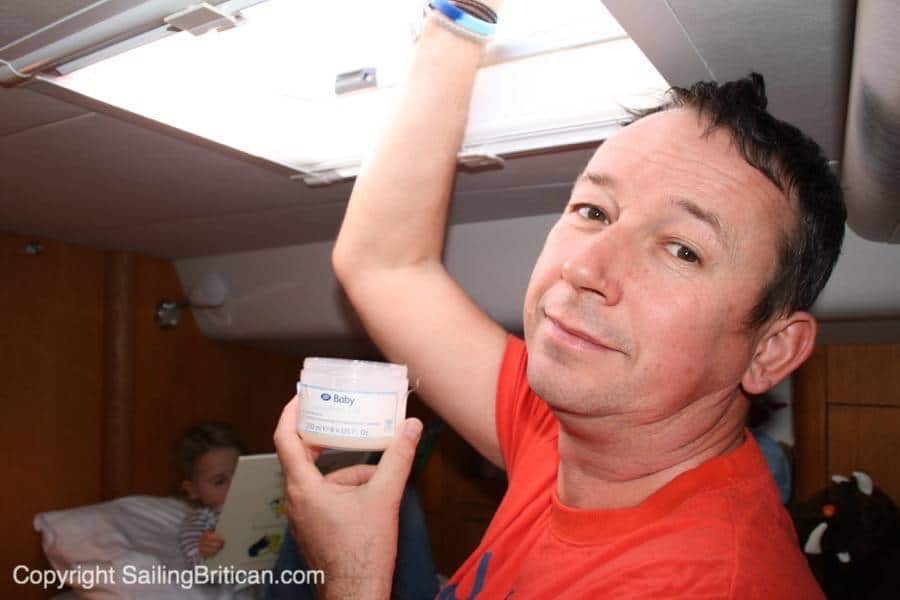
Our first year sailing our new boat has been an incredible year – year on will go down in history as being nothing short of remarkable. We’ve learned so much. At times I thought that my head was going to explode. At other times I put my head in my hands and thought, ‘how are we ever going to survive’?
Well…we’re still here, we’re still learning. And I’m sure we’ll be learning until we decide to dry up back on land. That being noted there is so much we have to learn. If you know of any tips you’d like to impart with us and the readers of this blog, please share! My motto is to learn from my mistakes so that you don’t have to make them yourself.
A must have for boat new boat owners
And if you’re a new boat owner yourself, please consider checking out my ‘Checklists for Sailors Guide – Checklists for Sailors – Passage Planning, Sailboat Maintenance, Cleaning, Medical and more,’ The guide is a boaters must-have checklist reference guide. When you’re first starting out you don’t know what you don’t know! These checklists will help you to:
- reduce mistakes
- reduce anxiety
- discover what you don’t know so that you do know it
- start somewhere and build on a solid foundation
Get more details about Checklists for Sailors here!
-
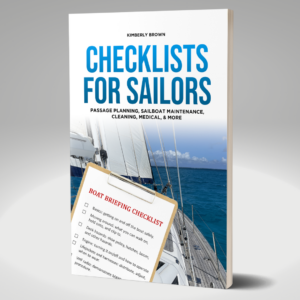 Buy
Buy
Boat Checklists for Sailors – 50+ Quick Start Lists
$27.00
Kim, another inspiring blog! I haven’t got time to leave a long reply just now, but I wanted you to know that you’re not talking to yourself! Big hugs to you all xxx
Once again Kim an amazing blog full of practical and sensible ideas.
One I will add is that anyone who has sea water toilets should always fill them with fresh water before leaving the boat for any length of time. It saves really dirty and really smelly loo’s when you get back.
Another is to get a husband who is willing to pose with a jar of Vaseline.. Brave man.
Hi there,
Thanks for the interesting article. We are up on the hard and have just done anti foul and I had heard of the egg whites before but were reluctant to try without investigation, so i googled it and your article came up. needless to say there is now already one coat of egg whites on and Im now waiting to put other coats on the Prop
We are similar to you guys, bought a boat a year ago in Croatia and have been on it since and its been a learning curve to say the least.
Once again thanks,
John and Shelly
Hey John and Shelly – great to hear from you. We’ll be taking our boat out of the water in May and we’ll be testing the egg white trick out for ourselves. Perhaps we’ll bump into each other this year and we can compare props – hehehehe. Big smiles, K
Kim, great blog. For your hatch seals, and rubber O rings, impellers, etc. you should use a clear, 100% silicone grease, not vaseline. The petroleum in the vaseline will break down rubber.
Thank you for that Ron…Silicone grease it is 🙂
I’m enjoying your blog, Kim.
I can’t live without baby wipes/wet wipes on the boat. They clean everything. They get anti foul paint off your skin and off the parts of boat where it is not meant to be!
We re-caulked our teak deck, a very messy job. Wet wipes get black sikaflex off your skin, feet, hair and the boat!!
I use them for cleaning grease, oil etc. My best friend on the boat!
Another interesting thing…our head (loo) stunk of rotten eggs, it was disgusting, after changing the outlet pipes, and even the Jabco pump, it still stank. We then discovered it was coming from the sea water inlet pipe. Where marine bacteria can grow and rot..
Regards Gayle
Great tips Gayle – I totally agree about the wipes. Anything that helps with sikaflex is a godsend. And it’s very interesting about the sea water inlet pipe…you may have saved me lots of time on our heads! Thank you 🙂
Hi All
A trick we learned with regards to props and anti fouling is Lanolin. Yup the same stuff we put on the nipples of nursing women. We had just taken our boat out for anti fouling and survey and the old survey guy told us this. My husband and I wrote it down quickly before the surveyor left and went to work with fact finding, mostly to find out what Lanolin was. Once we learned what it was and stopped giggling we started asking around the marina there were a bunch of sea dogs that knew of this trick and said it is a God send. We then learned we would have to get this stuff from a pharmacy, not at all expensive 3 CAD for half a pint. I of course sent Mike to the stores to locate this grease , as I figured and secretly hoped, he got a lot of weird looks from the pharmacists around town, considering half a pint of this stuff is quite a lot if your using it for nipples and pretty weird if your a guy using it. ahhh the small ways I get pleasure. Anyways he found it and we applied it. I think the only cons of Lanolin is it may be difficult to get in the size you want if you can get it at all. If I were pulling out in a spot where I might not be able to get Lanolin then I would probable go with egg whites, no brainer there chickens are everywhere in the world right? please say I’m right, no really I love eggs in the morning.
lisa and mike
SV ISKOTEO
Discovery Harbour Marina
Campbell River BC
Canada
Hi Lisa and Mike,
I am curious about an update on how the lanolin worked on the prop in our cold West Coast waters? We are in Maple Bay, Vancouver Island. In November we moved from a powerboat to a ferro cement schooner and trying to make it through our current cold snap.
Thanks!
Melanie & Neal
SV Kiva
Maple Bay, BC, Canada
Thank you Kim. Nice to see another woman of the sailing fraternity!
Hey Jo! There are a lot of us around 🙂 Woo woo woo!
Hey Lisa! What a great tip… I just jumped onto Amazon.com to see Lanolin is available easily here in the States. I found a 7oz and 14oz jar for $10 to $20… (Here’s what I found: http://amzn.to/2kKnLPl ) Instead of buying it from Amazon, however, I think I’d rather ask Simon to go buy some at the pharmacy. Hahahaha. We will certainly try that the next time we pull Britican out of the water. Smiles, Kim
Another tip about getting rid of squeaking floor boards is to use talcum powder on the underside of the boards.
That’s a GREAT TIP! I’m going to test that out this week 🙂 Thank you David.
I like your tip to use baby powder to prevent squeaky floorboards. A boat is often an expensive investment. You should take care of it so that it lasts long and can be easily resold if needed.
Good stuff Kim … even for a cruiser owner like me …. but with respect to your husband you can’t keep asking “red blooded” blokes if we like your T-shirt …. of course we like your T-shirt …. :-)))) . Cheers Mark (stink boat owner)
Re talc powder . It’s also very useful for tracing where leaks are coming from . Lay a trail around the pool of leak and you will see the trace of where it’s coming from, Then repeat as you follow the leak past floors bulkheads seals etc until u find the source . Simples….
Great tip! Thank you for sharing 😉 Kim
Kim, these are amazing boating tips. I liked this article please keep sharing such insights
Thank you Moong 🙂
Hi – Lots of good information here, but I thought I’d offer a ‘head’s up’ about Vaseline/Petroleum Gel on hatch gaskets – DON’T USE IT! – Silicone or any non-petroleum like Glycerine gel is fine, and works well, but any petroleum gel will in time harden the rubber, and cause leaks! I had heard that Vaseline was good, and thought our hatches leaked because of UV damage in the Caribbean. I had a student on a course who was a swimming pool maintenance engineer – he advised me that he frequently had to repair pumps that the well meaning owner had used Vaseline on – and the rubber gaskets had hardened. Ever since we have used Silicone or Glycerine and the hatches are much better!
Yes…you are 100% correct. I think others have also commented about the vaseline. Thank you for taking the time to write Pippa 🙂
Kim,
A great article – thanks.
The remedies for marine growth on propellers is almost worth a post on its own.
A Kiwi friend has a mixture of lanolin which he mixes with a secret blend of stuff, before applying it to a heated prop.
He swears by it.
Thanks,
Tim
We need to know about the secret blend Tim!
Hi U there!
I had my little outboard stuck with corrosion because of water inside the cylinder and crankshaft (my fault, stored it improperly upside down….only those doing nothing never mistake!) and a recipe from a mechanic fixed it in no time: he soaked it with a mixture of w40 plus engine oil (outboard one ) and most importantly coconut oil; less than 24 hours after it was unstuck and running again. That was a few years back, it’s still working good!
Francis
You know…W40 is amazing. I spray the stuff on everything now days! And we all know that Coconut oil rocks – the two together must make magic. Thank you for sharing Francis 🙂
Huh, I had no idea that the best solution to clean the interior of wood, ceiling panels, and the bathroom was vinegar. That’ll be really useful for keeping our boat clean. We’re thinking of replacing a watertight hatch on our boat– it’s pretty rusty and we wouldn’t want it to leak.
We use vinegar and water to clean everything 🙂 Smiles, Kim
Hi! Thank you for sharing your experiences and your boating tips. You have inspired me to try and approach the boating adventure in a different way. Let me explain. During a vacay in Turkey many years ago, I experienced a terrible scare in the sea. One day before our(husband and me) departure, I decided to enter the sea one last time(against the advice of my husband)…As soon as I entered the magnificent water, I was swallowed. The sea turned me upside down(I saw nothing but gray and felt like I was inside a huge giant whirlpool)…I held my breath, let go, let God, and prayed. Then I heard my husband scream “”Get out!'”…but I had no control..After a while, the sea decided I’d learned my lesson, and spat me out…my body was tided in(boom!) against the beach bank, bikini top up over my breasts, mouth full of sand. After I recovered from the shock, I noticed that a Turkish man, crouched at the beach edge, had observed the entire drama(I quickly pulled down my bikini top)…My husband approached to see if I was okay…..He saw that I was not and offered comfort…And the sea had taken my wedding ring…Wow! It was so snug on my finger……Since that time, I have utmost respect for the sea..and in all honesty… a little trepidation…I’d rather stay close to harbors ……Now, about boating…Fast forward…..2019…After a two month search, my husband just finalised his second boat purchase. The first boat offered multiple challenges. Gasoline pump malfunction, rutter descension challenges…etc…..The plan is to pick up the boat, sail from Brindisi to Otranto, overnighter, then continue until we reach Torre Colimena(Italy). My husband’s desire is to eventually sail to Greece. I will tell my husband about your book Checklist for Sailors. I have lanolin, glycerine, W40, and vinegar, but any tips about anxiety issues? Totally able, but willing?
I loved when you mentioned that you could use vinegar water to help clean your boat properly. My wife and I might get a boat for this Christmas, and it would be important for us to know that we could keep it in great condition. When we do, I will be sure to use vinegar water to thoroughly clean it out.
Vinegar who knew? Great tips thanks for sharing.
This is an amazing list of boat maintenance hacks. I have never heard of so many — the egg whites blew me away. I am going to keep this list and check back with your great blog. I am so impressed. Thanks for sharing these tips!